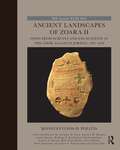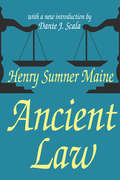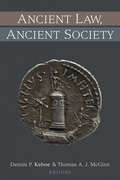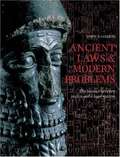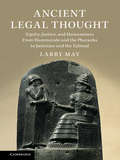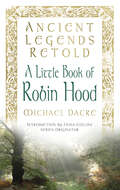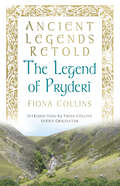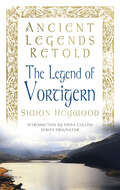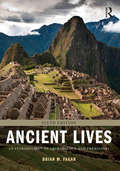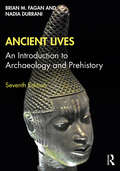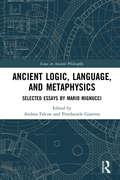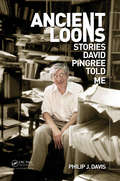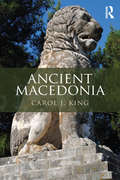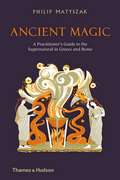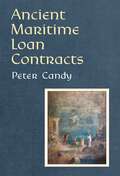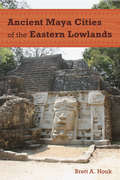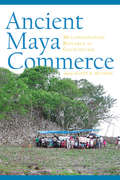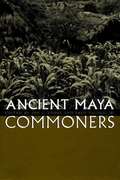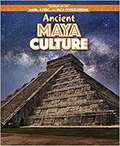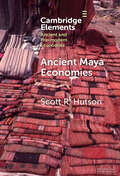- Table View
- List View
Ancient Landscapes of Zoara II: Finds from Surveys and Excavations at the Ghor as-Safi in Jordan, 1997–2018 (The Palestine Exploration Fund Annual)
by Peter Edwell Konstantinos D. Politis Anthony D. Grey Annette M. Hansen Louise Joyner Kalliope I. Kritikakou-Nikolaropoulou Louise A. Martin Rula Nuri Shafiq Sofia Laparidou Georgios A. Papaioannou Aliza TaftAncient Landscapes of Zoara II reveals the unique set of objects discovered through the meticulous excavations at the Ghor as-Safi in Jordan. Some of them are unique works of art, but others are no less valuable for the knowledge they hold. Complementing the previous volume Ancient Landscapes of Zoara I, this book explores Ghor as-Safi’s ancient history and archaeology through the material remains found during excavations. The finds described are from historical periods and include unpublished early Christian and Aramaic inscriptions as well as Arabic writing and graffiti. Newly discovered mosaic pavements are presented along with other noteworthy finds such as glazed imported wares, local industrial pottery, fine glass, an array of coins and specialised metal work. Animal and plant remains testify to varied and rich agricultural regimes which sustained the prosperity of ancient communities. In turn, this affluence seems to have led to a fairly sophisticated and literate society in an otherwise rather desolate environment. Studies on the human remains affirm a robust population. Ancient Landscapes of Zoara II, as with the previous volume, is aimed at students and researchers of the archaeology of the Near East and the southern Levant in particular. It is also of interest to readers wishing to further their understanding of the region’s medieval cultures, with a focus on material finds from archaeological excavations belonging to the Byzantine and Islamic periods.
Ancient Law
by Dante J. Scala Sir Henry MaineBest known as a history of progress, Ancient Law is the enduring work of the 19th-century legal historian Henry Sumner Maine. Even those who have never read Ancient Law may find Maine's famous phrase "from status to contract" familiar. His narrative spans the ancient world, in which individuals were tightly bound by status to traditional groups, and the modern one, in which individuals are viewed as autonomous beings, free to make contracts and form associations with whomever they choose. Maine's dichotomy between status-based societies and contract-based societies is a variation on a theme that has absorbed the social sciences for a century: the distinction between Gemeinschaft (community) and Gesellschaft (society). This theme has been elaborated upon by such eminent scholars as Tonnies, Durkheim, Weber, Simmel, and Parsons. Along with many lesser scholars, they have considered what we gained and what we lost when we left behind a social world held together by communal, primordial bonds, and adopted one based upon impersonal temporary agreements among individuals. Maine wrote Ancient Law to increase knowledge about the internal mechanics of developing societies. He felt a key objective was better understanding of how law develops over time. Failure to understand temporal processes in relation to legal development, he argues, leads to the creation of false dichotomies. The most important of these is the alleged division between the ancient and the modern, which Maine described as an "imaginary barrier" at which modern scholars feel they must stop and go no further. Maine's desire to breach this barrier led him to present this complex and richly nuanced analysis of legal evolution. This book will be of interest to historians, political philosophers, and those interested in the development of law.
Ancient Law, Ancient Society
by Dennis P. Kehoe Thomas McginnThe essays composing Ancient Law, Ancient Society examine the law in classical antiquity both as a product of the society in which it developed and as one of the most important forces shaping that society. Contributors to this volume consider the law via innovative methodological approaches and theoretical perspectives—in particular, those drawn from the new institutional economics and the intersection of law and economics. Essays cover topics such as using collective sanctions to enforce legal norms; the Greek elite’s marriage strategies for amassing financial resources essential for a public career; defenses against murder charges under Athenian criminal law, particularly in cases where the victim put his own life in peril; the interplay between Roman law and provincial institutions in regulating water rights; the Severan-age Greek author Aelian’s notions of justice and their influence on late-classical Roman jurisprudence; Roman jurists’ approach to the contract of mandate in balancing the changing needs of society against respect for upper-class concepts of duty and reciprocity; whether the Roman legal authorities developed the law exclusively to serve the Roman elite’s interests or to meet the needs of the Roman Empire’s broader population as well; and an analysis of the Senatus Consultum Claudianum in the Code of Justinian demonstrating how the late Roman government adapted classical law to address marriage between free women and men classified as coloni bound to their land. In addition to volume editors Dennis P. Kehoe and Thomas A. J. McGinn, contributors include Adriaan Lanni, Michael Leese, David Phillips, Cynthia Bannon, Lauren Caldwell, Charles Pazdernik, and Clifford Ando.
Ancient Laws and Modern Problems: The Balance Between Justice and a Legal System
by John SassoonThe author’s study of the written laws of four thousand years ago puts paid to the belief that the most ancient laws were merely arbitrary and tyrannical. On the contrary, the earliest legal systems honestly tried to get to the truth, do justice to individuals, and preserve civil order. They used the death penalty surprisingly seldom, and then more because society had been threatened than an individual killed. Some of the surviving law codes are originals, others near-contemporary copies. Together they preserve a partial but vivid picture of life in the early cites. This occupies more than half the book. Comparison of ancient with modern principles occupies the remainder and is bound to be controversial; but it is important as well as fascinating. The first act of writing laws diminished the discretion of the judges and foretold a limit on individual justice. Some political principles such as uniformity of treatment or individual freedom have, when carried to extremes, produced crises in modern legal systems world wide. But it is tempting but wrong to blame the judges or the lawyers for doing what society require of them.
Ancient Legal Thought: Equity, Justice, and Humaneness From Hammurabi and the Pharaohs to Justinian and the Talmud
by Larry MayThis is a study of what constituted legality and the role of law in ancient societies. Investigating and comparing legal codes and legal thinking of the ancient societies of Mesopotamia, Egypt, Greece, India, the Roman Republic, the Roman Empire and of the ancient Rabbis, this volume examines how people used law to create stable societies. Starting with Hammurabi's Code, this volume also analyzes the law of the pharaohs and the codes of the ancient rabbis and of the Roman Emperor Justinian. Focusing on the key concepts of justice equity and humaneness, the status of women and slaves, and the idea of criminality and of war and peace; no other book attempts to examine such diverse legal systems and legal thinking from the ancient world.
Ancient Legends Retold: A Little Book of Robin Hood (Ancient Legends Retold)
by Fiona Collins Michael DacreThis collection of five tales and one play contains the definitive Robin Hood. They are the earliest ballads and play and still the best of the bunch. ‘Robin Hood and the Monk’ is the earliest surviving manuscript, dated c.1450, and is considered the greatest of the ballads, though it was probably not sung, being described as a ‘talkyng’; ‘Robin Hood’s Death’ is one of the most satisfying tragedies in the English language; while ‘A Lytell Geste of Robyn Hode’ is a comprehensive account of the famous English outlaw - complete, unified and pointing quite clearly to the reign of Edward II as a probable time for an historical Robin Hood, despite the opinions of most of the experts.
Ancient Legends Retold: The Legend of Pryderi (Ancient Legends Retold)
by Fiona CollinsThe Four Branches of the Mabinogion are a rich treasure trove of tales. These magical, quintessentially Welsh stories are confusing, but it would be hard to match their splendid strangeness. The Four Branches tell of the kings and queens of Wales in the time of’ ‘Once upon a time’. Only one character appears in all Four Branches. He is Pryderi, and the story of his life journey is told in this book. Pryderi is brave and bold: sometimes foolhardy, always fiercely loyal. The stories of two beautiful, powerful women entwine with his: Rhiannon of the Birds, his mother, and Cigfa, his wife. Both accompany him on his life path. But, at the last, Pryderi must go on alone. Here, for the first time, his tale is told from beginning to end.
Ancient Legends Retold: The Legend of Vortigern (Ancient Legends Retold)
by Fiona Collins Simon Heywood'My name is Vortigern ... ' Generations before Arthur's birth, a British warlord looks back on his life: his rise from humble roots to shake the thrones of a dying empire; his stand against chaos amid the aftermath of Rome; his struggle with the greedy, embittered princes of church and kingdom; his loves and his losses, and his last encounter with his own mysterious destiny, on a mountain where the world we know is beginning to take shape before his eyes. Vortigern's voice speaks from the heart of a forgotten darkness, telling a story of courage and cowardice, glory and crime, tragedy and treason.
Ancient Legends of Ireland
by Lady Jane WildeThis beautiful keepsake edition of Ancient Legends of Ireland is lavishly illustrated with 22 period illustrations. While Lady Jane Francesca Agnes Wilde is probably best known for being Oscar Wilde&’s mother, she was a formidable writer in her own right. The people of Ireland owe Lady Wild a great debt for collecting and persevering folk-lore that might otherwise have been lost to them. The present work deals with the mythology, or the fantastic creed of the Irish respecting the invisible world and their strange and mystical superstitions, brought thousands of years ago from their Aryan home, but which still, even in the present time, affect all the modes of thinking and acting in the daily life of the people. Told with power as well as with simplicity ... a very interesting and readable collection of folk-lore.—Graphic. Lady Wilde&’s book is delightful.... Amongst those best acquainted with Irish folk-lore, legends, and mysteries, we believe few will be found capable of adding many words to pages which could only have been filled by an Irish woman lovingly treating such a subject.—Vanity Fair.
Ancient Libraries
by Jason König Jason König Katerina Oikonomopoulou Greg Woolf Katerina OikonomopoulouThe circulation of books was the motor of classical civilization. But books were both expensive and rare, and so libraries - private and public, royal and civic - played key roles in articulating intellectual life. This collection, written by an international team of scholars, presents a fundamental reassessment of how ancient libraries came into being, how they were organized and how they were used. Drawing on papyrology and archaeology, and on accounts written by those who read and wrote in them, it presents new research on reading cultures, on book collecting and on the origins of monumental library buildings. Many of the traditional stories told about ancient libraries are challenged. Few were really enormous, none were designed as research centres, and occasional conflagrations do not explain the loss of most ancient texts. But the central place of libraries in Greco-Roman culture emerges more clearly than ever.
Ancient Lives: An Introduction to Archaeology and Prehistory
by Brian M. FaganFocusing on sites of key significance and the world's first civilizations, Ancient Lives is an accessible and engaging textbook which introduces complete beginners to the fascinating worlds of archaeology and prehistory. Drawing on their impressive combined experience of the field and the classroom, the authors use a jargon-free narrative style to enliven the major developments of more than three million years of human life. First introducing the basic principles, methods and theoretical approaches of archaeology, the book then provides a summary of world prehistory from a global perspective, exploring human origins and the reality of life in the archaic world. Later chapters describe the development of agriculture and animal domestication and the emergence of cities, states, and pre-industrial civilizations in widely separated parts of the world. With this new edition updated to reflect the latest discoveries and research in the discipline, Ancient Lives continues to be a comprehensive and essential introduction to archaeology.
Ancient Lives: An Introduction to Archaeology and Prehistory
by Brian M. Fagan Nadia DurraniFocusing on sites of key significance and the world’s first civilizations, Ancient Lives is an accessible and engaging textbook which introduces complete beginners to the fascinating worlds of archaeology and prehistory. Drawing on their impressive combined experience of the field and the classroom, the authors use a jargon-free narrative style to enliven the major developments of more than 3 million years of human culture. First introducing the basic principles, methods, and theoretical approaches of archaeology, the book then provides a summary of world prehistory from a global perspective. This latest edition provides an up-to-date account of human evolution and the origins of modern humans. It explores the reality of life in the prehistoric world. Later chapters describe the development of agriculture and animal domestication, and the emergence of cities, states, and preindustrial civilizations in widely separated parts of the world. Our knowledge of these is changing thanks to revolutionary developments in LIDAR (light detection and ranging) technology and other remote-sensing devices. With this new edition updated to reflect the latest discoveries and research in the discipline, Ancient Lives continues to be a comprehensive and essential introduction to archaeology. It will be ideal for students looking for an accessible guide to the subject.
Ancient Logic, Language, and Metaphysics: Selected Essays by Mario Mignucci (Issues in Ancient Philosophy)
by Andrea Falcon Pierdaniele GiarettaThe late Mario Mignucci was one of the most authoritative, original, and influential scholars in the area of ancient philosophy, especially ancient logic. Collected here for the first time are sixteen of his most important essays on Ancient Logic, Language, and Metaphysics. These essays show a perceptive historian and a skillful logician philosophically engaged with issues that are still at the very heart of history and philosophy of logic, such as the nature of predication, identity, and modality. As well as essays found in disparate publications, often not easily available online, the volume includes an article on Plato and the relatives translated into English for the first time and an unpublished paper on De interpretatione 7. Mignucci thinks rigorously and writes clearly. He brings the deep knowledge of a scholar and the precision of a logician to bear on some of the trickiest topics in ancient philosophy. This collection deserves the close attention of anyone concerned with logic, language, and metaphysics, whether in ancient or contemporary philosophy.
Ancient Loons: Stories Pingree Told Me
by Philip J. Davis"Ah, I'm Pingree. We meet again. Splendid. Won't you sit down?"I looked around David's room. Short of the library stacks, I had never seen so many books piled into a single room. Where could I sit down? Every square inch of horizontal surface was covered. Books, papers, notes, manuscripts-all congregated in random and chaotic disorder.This small en
Ancient Macedonia
by Carol J. KingThe first English-language monograph on ancient Macedonia in almost thirty years, Carol J. King's book provides a detailed narrative account of the rise and fall of Macedonian power in the Balkan Peninsula and the Aegean region during the five-hundred-year period of the Macedonian monarchy from the seventh to the second century BCE. King draws largely on ancient literary sources for her account, citing both contemporary and later classical authors. Material evidence from the fields of archaeology, epigraphy, and numismatics is also explored. Ancient Macedonia balances historical evidence with interpretations—those of the author as well as other historians—and encourages the reader to engage closely with the source material and the historical questions that material often raises. This volume will be of great interest to both under- and post-graduate students, and those looking to understand the fundamentals of the period.
Ancient Magic: A Practitioner's Guide To The Supernatural In Greece And Rome
by Philip MatyszakAn accessible historical exploration of the methods and motivations behind using magic in ancient Greece and Rome. In the ancient world, magic was everywhere. The supernatural abounded, turning flowers into fruit and caterpillars into butterflies. In a time before scientists studied weather patterns and figured out what caused the Earth’s most mysterious phenomena, it was magic that packed a cloud full of energy until it exploded with thunderbolts. It was everyday magic, but it was still magical. In Ancient Magic, author Philip Matyszak ushers readers into that world, showing how ancient Greeks and Romans concocted love potions and cast curses, how they talked to the dead and protected themselves from evil spirits. He takes readers to a world where gods interacted with humans and where people could not only talk to spirits and deities, but could themselves become divine. Ancient Magic presents us with a new understanding of the role of magic, combining a classical historiography with a practical how-to guide. Using a wide array of sources and lavish illustrations, this book offers an engaging and accessible way into the supernatural for all.
Ancient Manifestation Secrets: Working with the 7 Laws of the Universe to Manifest Your Life and Purpose
by George Lizos• Draws on ancient Greek and Egyptian wisdom to explain the 7 manifestation laws of the Universe and how to discover which desires align with your higher purpose• Shares a 5-step process for manifesting your desires and a 10-day manifestation challenge for achieving a singular chosen goal• Presents inner work practices for releasing cognitive and emotional blocks and limiting beliefs that hinder your manifestation journeyWho would not want to become a skilled conscious creator of their life? Diving deep into Hermetic philosophy and the initatic text The Kybalion, manifestation expert George Lizos uncovers the intricate energetic processes and Universal laws that underlie effective manifestation work—the law of attraction being only one step on this way.Ancient Manifestation Secrets teaches a revolutionary 5-step method for successfully manifesting your desires by aligning your energetic field with the 7 laws of the Universe. As you incorporate inner work into the manifestation process, you find energetic practices for releasing and transmuting cognitive and emotional blocks and limiting beliefs that might have hindered success up to now. While not all you wish for is able to manifest, you will discover how to discern which desires are aligned with your higher purpose and Universal laws and how to work with this alignment.Based on ancient wisdom and techniques, this practical guide provides a precise plan of action for manifestation, with effective exercises and inspiring examples illustrating each step. Start manifesting consciously today with your personal 10-day challenge!
Ancient Maritime Loan Contracts (Law And Society In The Ancient World)
by Peter CandyAncient Maritime Loan Contracts studies the first millennium of the standard form contracts at the heart of ancient long-distance trade, from the fifth century BCE to Justinian. Maritime loan contracts recorded the terms of agreement on which a creditor lent a sum of money to a merchant or carrier to finance the purchase of a cargo for a trading expedition overseas. They were the lifeblood of the long-distance trade in bulk commodities that flourished in the Mediterranean and Black Seas and were also among the first private agreements to be fully committed to writing. From at least the fifth century BCE, these contracts were highly standardized in their terms, containing boilerplate clauses in a tried-and-tested construction. Maritime loan contracts continued to be used to finance maritime trade until the late Middle Ages, when they were only finally superseded by the contract of marine insurance. Combining a wide variety of papyrological, epigraphic, and legal evidence, Peter Candy’s framework illustrates the significance of these contracts in both their economic and legal context. By using an interdisciplinary approach, Ancient Maritime Loan Contracts addresses important questions about how maritime trade was financed in the context of the ancient economy; the response of individual legal cultures to maritime loan contracts; and the relationship between international commercial practice and legal development in the ancient world.
Ancient Mathematics (Sciences of Antiquity)
by Serafina CuomoThe theorem of Pythagoras, Euclid's "Elements", Archimedes' method to find the volume of a sphere: all parts of the invaluable legacy of ancient mathematics. But ancient mathematics was also about counting and measuring, surveying land and attributing mystical significance to the number six. This volume offers the first accessible survey of the discipline in all its variety and diversity of practices. The period covered ranges from the fifth century BC to the sixth century AD, with the focus on the Mediterranean region. Topics include:* mathematics and politics in classical Greece* the formation of mathematical traditions* the self-image of mathematicians in the Graeco-Roman period* mathematics and Christianity* and the use of the mathematical past in late antiquity.
Ancient Maya Cities of the Eastern Lowlands (Ancient Cities of the New World)
by Brett A. Houk"Brings together for the first time all the major sites of this part of the Maya world and helps us understand how the ancient Maya planned and built their beautiful cities. It will become both a handbook and a source of ideas for other archaeologists for years to come."--George J. Bey III, coeditor of Pottery Economics in Mesoamerica "Skillfully integrates the social histories of urban development."--Vernon L. Scarborough, author of The Flow of Power: Ancient Water Systems and Landscapes "Any scholar interested in urban planning and the built environment will find this book engaging and useful."--Lisa J. Lucero, author of Water and Ritual For more than a century researchers have studied Maya ruins, and sites like Tikal, Palenque, Copán, and Chichén Itzá have shaped our understanding of the Maya. Yet cities of the eastern lowlands of Belize, an area that was home to a rich urban tradition that persisted and evolved for almost 2,000 years, are treated as peripheral to these great Classic period sites. The hot and humid climate and dense forests are inhospitable and make preservation of the ruins difficult, but this oft-ignored area reveals much about Maya urbanism and culture. Using data collected from different sites throughout the lowlands, including the Vaca Plateau and the Belize River Valley, Brett Houk presents the first synthesis of these unique ruins and discusses methods for mapping and excavating them. Considering the sites through the analytical lenses of the built environment and ancient urban planning, Houk vividly reconstructs their political history, considers how they fit into the larger political landscape of the Classic Maya, and examines what they tell us about Maya city building.
Ancient Maya Commerce: Multidisciplinary Research at Chunchucmil
by Scott HutsonAncient Maya Commerce presents nearly two decades of multidisciplinary research at Chunchucmil, Yucatan, Mexico—a thriving Classic period Maya center organized around commercial exchange rather than agriculture. An urban center without a king and unable to sustain agrarian independence, Chunchucmil is a rare example of a Maya city in which economics, not political rituals, served as the engine of growth. Trade was the raison d’être of the city itself. Using a variety of evidence—archaeological, botanical, geomorphological, and soil-based—contributors show how the city was a major center for both short- and long-distance trade, integrating the Guatemalan highlands, the Gulf of Mexico, and the interior of the northern Maya lowlands. By placing Chunchucmil into the broader context of emerging research at other Maya cities, the book reorients the understanding of ancient Maya economies. The book is accompanied by a highly detailed digital map that reveals the dense population of the city and the hundreds of streets its inhabitants constructed to make the city navigable, shifting the knowledge of urbanism among the ancient Maya. Ancient Maya Commerce is a pioneering, thoroughly documented case study of a premodern market center and makes a strong case for the importance of early market economies in the Maya region. It will be a valuable addition to the literature for Mayanists, Mesoamericanists, economic anthropologists, and environmental archaeologists. Contributors: Anthony P. Andrews, Traci Ardren, Sheryl Luzzadder-Beach, Timothy Beach, Chelsea Blackmore, Tara Bond-Freeman, Bruce H. Dahlin, Patrice Farrell, David Hixson, Socorro Jimenez, Justin Lowry, Aline Magnoni, Eugenia Mansell, Daniel E. Mazeau, Travis Stanton, Ryan V. Sweetwood, Richard E. Terry
Ancient Maya Commoners
by Jon Lohse Fred ValdezMuch of what we currently know about the ancient Maya concerns the activities of the elites who ruled the societies and left records of their deeds carved on the monumental buildings and sculptures that remain as silent testimony to their power and status. But what do we know of the common folk who labored to build the temple complexes and palaces and grew the food that fed all of Maya society? This pathfinding book marshals a wide array of archaeological, ethnohistorical, and ethnographic evidence to offer the fullest understanding to date of the lifeways of ancient Maya commoners. Senior and emerging scholars contribute case studies that examine such aspects of commoner life as settlement patterns, household organization, and subsistence practices. Their reports cover most of the Maya area and the entire time span from Preclassic to Postclassic. This broad range of data helps resolve Maya commoners from a faceless mass into individual actors who successfully adapted to their social environment and who also held primary responsibility for producing the food and many other goods on which the whole Maya society depended.
Ancient Maya Culture (Spotlight on the Maya, Aztec, and Inca Civilizations)
by Christine HondersFor hundreds of years, archaeologists have unearthed clues about the amazing culture of the ancient Maya. This book brings the culture of this ancient civilization to life. Readers will learn about the ancient Maya economy, technology, rituals and traditions, family systems, politics, and daily life. Primary sources such as artifacts and ruins allow readers to connect with the past on a deep level. Amazing artwork and photographs allow readers to visualize the backdrop of ancient Maya culture as it exists today and as it’s imagined to have existed hundreds of years ago at its peak. Readers are in for a thrilling adventure with this firsthand look into the wonders of Maya culture.
Ancient Maya Daily Life (Spotlight on the Maya, Aztec, and Inca Civilizations Series)
by Heather Moore NiverWhat was life like in the days of the ancient Maya civilization? Where did people live and what did they do each day? These questions and more are answered in this fact-filled book about the daily life of the ancient Maya. Engaging text and primary sources shed light on the many mysteries of the Maya people. Color photographs of existing architecture and artifacts, as well as artwork, will transport readers back to the days when the Maya civilization was thriving. <p><p>This exciting book is rich with information about Maya culture, and it's sure to stoke readers' imaginations while giving them a deep understanding of the history of this ancient civilization.
Ancient Maya Economies (Elements in Ancient and Pre-modern Economies)
by Scott R. HutsonAncient Maya Economies synthesizes the state of the art across seven components: geographical and historical background, ritual economy, households, specialization, exchange, political economies, and future directions. Other Elements case studies use many of the same components, making it easy to compare and contrast ancient Maya economies with systems of production and consumption in other parts of the world. The time is right for this Elements case because knowledge of ancient Maya economies has undergone a revolution in the last few decades, resulting in a complex panorama of new economic information. Aerial laser scanning has revealed higher amounts of intensive agriculture and research on the ground has turned up better evidence for marketplaces. Maya economies feature specialized production, trade of both bulk goods and luxury goods, close integration with ritual and religion, and a carnival parade of political economies.
